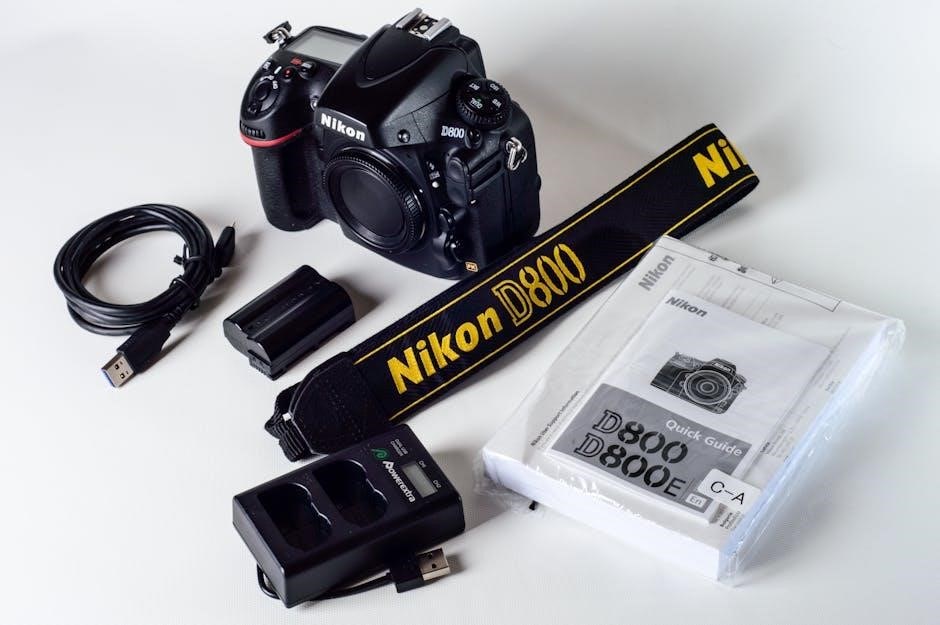nikon f4 instruction manual
Welcome to the Nikon F4 instruction manual, your comprehensive guide to mastering this legendary camera․ This manual covers setup, features, shooting modes, and maintenance, ensuring optimal performance and creativity․
1․1 Overview of the Nikon F4 Camera
The Nikon F4 is a professional-grade 35mm film SLR camera introduced in 1988․ Known for its durability and advanced features, it offers a multi-area autofocus system, various metering modes, and multiple exposure control options․ Designed for both professionals and enthusiasts, the F4 combines intuitive controls with robust construction, making it a versatile tool for capturing high-quality images․ Its ergonomic design and comprehensive feature set ensure precise control over photography settings, catering to diverse shooting scenarios and creative needs․
1․2 Importance of Reading the Manual
Reading the Nikon F4 manual is essential to unlock its full potential․ This guide provides detailed instructions on camera setup, operation, and troubleshooting, ensuring optimal performance․ Proper understanding of features like autofocus, metering modes, and exposure controls enhances creativity and image quality․ The manual also covers maintenance tips, preventing common issues and extending the camera’s lifespan․ By familiarizing yourself with the manual, you can maximize the F4’s capabilities and achieve professional-grade photography results consistently․

Key Features of the Nikon F4
The Nikon F4 boasts advanced autofocus, multiple metering modes, and versatile exposure controls․ Its robust design and user-friendly interface make it a preferred choice for professionals and enthusiasts․
2․1 Autofocus System

The Nikon F4 features a multi-area autofocus system, ensuring precise focusing even in low-light conditions․ With advanced sensors and predictive tracking, it captures sharp images effortlessly, enhancing your photography experience significantly․
2․2 Metering Modes
The Nikon F4 offers versatile metering modes to suit various lighting conditions․ It features spot, center-weighted, and matrix metering, providing precise exposure control․ Spot metering focuses on specific areas, while center-weighted emphasizes the central frame․ Matrix metering balances the entire scene for optimal results, ensuring your photos capture the intended lighting and detail effectively in any situation․
2․3 Exposure Modes
The Nikon F4 offers four primary exposure modes: Manual (M), Programmed, Shutter-Priority (S), and Aperture-Priority (A)․ Manual mode provides full control over aperture and shutter speed, while Programmed mode offers automatic adjustments with user flexibility․ Shutter-Priority mode prioritizes shutter speed for capturing motion, and Aperture-Priority mode focuses on depth of field control․ These modes cater to different shooting scenarios, ensuring photographers can adapt to various lighting and creative demands effectively․

Camera Interface and Layout
The Nikon F4 features an intuitive interface with a logical layout, designed for easy access to controls․ The camera’s ergonomic design enhances usability, ensuring a seamless shooting experience․
3;1 Top Control Layout
The top of the Nikon F4 houses essential controls for quick access․ The shutter speed dial, exposure compensation button, and ISO button are strategically placed for easy adjustment․ The film advance mode selector and lock release button are positioned near the shutter release for intuitive operation․ These controls allow photographers to make rapid adjustments without diverting attention from their subject, ensuring a fluid and efficient shooting workflow․ The layout is designed to balance functionality with comfort, catering to both amateur and professional photographers․
3․2 Rear Control Layout
The rear of the Nikon F4 features a user-friendly layout designed for seamless control․ The LCD panel displays critical settings like exposure compensation and frame count․ Below it, the command dial allows for quick adjustments of aperture, shutter speed, or exposure compensation․ The AF-ON button enables manual focus override, while the review button provides instant access to the last captured image․ Additional controls include the diopter adjustment for the viewfinder, ensuring optimal focus for photographers with varying vision needs․ This intuitive design enhances shooting efficiency and customization․
3․3 Viewfinder Features
The Nikon F4’s viewfinder offers a high-eyepoint design with 100% frame coverage, providing an unobstructed view of your subject․ The built-in diopter adjustment ensures sharp focus for photographers with varying vision needs․ The viewfinder also features an electronic rangefinder that illuminates when focus is achieved, aiding manual focusing․ Additional information like exposure data and flash status is displayed below the frame, making it easy to monitor settings without removing your eye from the viewfinder, enhancing both accuracy and shooting efficiency․

Setting Up the Camera
Setting up the Nikon F4 involves loading film, inserting batteries, and configuring initial settings․ Ensure the camera is powered on and ready for optimal performance and precise control․
4․1 Loading Film
Loading film into the Nikon F4 is a straightforward process․ Open the camera back by sliding the release latch․ Align the film cartridge with the spool, ensuring it clicks into place․ Advance the film by turning the crank until the start mark appears in the window․ Close the back securely and verify the film counter resets․ Always load film in low-light conditions or use a changing bag to prevent exposure․ Proper loading ensures accurate framing and consistent results․
4․2 Battery Management
Proper battery management is crucial for the Nikon F4’s operation․ Use 4 AA alkaline or nickel-cadmium batteries for reliable performance․ Insert batteries into the MB-20 battery pack, ensuring correct polarity․ Avoid mixing battery types to prevent power issues․ Replace batteries when the low-battery indicator appears in the viewfinder․ Store batteries in a cool, dry place to maintain longevity․ Always check battery levels before extended shoots to ensure uninterrupted use․ Proper care extends the camera’s functionality and ensures consistent operation․
4․3 Initial Setup and Configuration
Begin by assembling the Nikon F4 with the MB-20 battery pack and attaching any optional accessories․ Insert the batteries, ensuring correct orientation, and secure the pack․ Turn on the camera by pressing the lock release button and rotating the film advance selector․ Set the film advance mode, ISO sensitivity, and exposure compensation as needed․ Familiarize yourself with the camera’s controls and customize settings to suit your preferences․ Proper initial setup ensures smooth operation and optimal performance during photography sessions․
Shooting Modes
The Nikon F4 offers versatile shooting modes, including Manual (M), Program, Shutter-Priority (S), and Aperture-Priority (A), catering to various photographic needs and preferences․
5․1 Manual Mode
Manual Mode (M) offers full control over aperture, shutter speed, and ISO, allowing photographers to customize settings for precise results․ Use the exposure compensation dial to adjust settings and ensure optimal exposure․ The Nikon F4’s electronic rangefinder provides precise focusing guidance, indicated by an LED light in the viewfinder․ This mode is ideal for experienced photographers seeking creative control and is particularly useful in challenging lighting conditions where automatic modes may fall short․
5․2 Program Mode
Program Mode (P) automates aperture and shutter speed settings, offering a balance between ease of use and creative flexibility․ The camera selects optimal exposure settings, but users can adjust exposure compensation for fine-tuning․ This mode is ideal for everyday shooting, allowing quick adjustments without manual controls․ It’s perfect for candid photography and dynamic lighting conditions, ensuring sharp, well-exposed images effortlessly․ The electronic rangefinder assists in precise focusing, making Program Mode a versatile choice for photographers of all skill levels․
5․3 Shutter-Priority Mode
In Shutter-Priority Mode (S), you set the shutter speed, and the camera automatically adjusts the aperture for optimal exposure․ This mode is ideal for controlling motion effects, such as freezing fast-moving subjects or creating blurred backgrounds․ With the Nikon F4, you can select shutter speeds from 1/250 sec to 8 sec, allowing precise control over action and light․ Exposure compensation is also available for fine-tuning, ensuring your images capture the desired mood and effect effortlessly․
5․4 Aperture-Priority Mode
Aperture-Priority Mode (A) allows you to set the lens aperture, while the camera automatically adjusts the shutter speed․ This mode is perfect for controlling depth of field, ensuring sharp focus on your subject while softly blurring the background․ The Nikon F4 offers a wide range of aperture settings, making it easy to achieve professional-looking portraits and landscapes․ By adjusting the aperture, you can creatively influence the overall composition and lighting of your images with precision and ease․
Focusing Techniques
Master manual and autofocus techniques with the Nikon F4․ Manual focusing offers precise control, while autofocus provides speed and accuracy, even in challenging lighting conditions․
6․1 Manual Focusing
Manual focusing on the Nikon F4 is precise and straightforward․ Use the Electronic Rangefinder, which provides an LED indication to guide accurate focus․ Simply turn the lens focus ring until the subject is sharp․ The viewfinder displays arrows to indicate direction․ Ensure steady handling, especially in low light․ For critical focus, use a tripod or stabilize the camera; This method offers full creative control, ideal for specific compositions or when autofocus may not detect the subject accurately․
6․2 Autofocus Operation
The Nikon F4 features a multi-area autofocus system, offering accurate focusing even in low-light conditions․ Select from multiple focus areas to ensure sharp results․ Activate autofocus by pressing the shutter release halfway; the camera emits a confirmation beep and highlights the selected area․ For moving subjects, continuous autofocus tracking enhances capture precision․ Use the focus lock to maintain focus on stationary subjects․ This advanced system balances speed and accuracy, making it versatile for various photography scenarios and lighting environments, ensuring professional-grade results consistently․

Additional Features
The Nikon F4 offers a built-in flash, mirror lock-up, and self-timer, enhancing versatility and convenience for photographers․ These features expand creative possibilities and improve shooting efficiency․
7․1 Built-in Flash
The Nikon F4 features a convenient built-in flash, providing additional lighting when natural light is insufficient․ It automatically activates in low-light conditions and synchronizes with the camera’s shutter․ With a guide number of 12 (ISO 100), it offers sufficient coverage for close-range subjects․ The flash can also be manually activated for creative control․ When using the built-in flash, ensure the ISO setting is compatible for optimal results․ This feature enhances versatility, allowing photographers to capture well-lit images in various scenarios․
7․2 Mirror Lock-Up
The Mirror Lock-Up feature on the Nikon F4 minimizes camera shake caused by mirror movement․ Ideal for macro, telephoto, or low-light photography, it ensures sharper images by locking the mirror in the raised position before exposure․ Activate this mode via the camera’s custom settings to reduce vibrations․ Use a remote shutter release or the self-timer for best results, as physical contact with the camera can reintroduce shake․ This feature is particularly useful for precise, high-magnification or long-exposure shots where stability is critical․
7․3 Self-Timer
The Nikon F4’s self-timer allows a 10-second delay between shutter release and image capture, reducing camera shake caused by manual triggering․ Activate it via the camera’s control panel to ensure sharp images․ Perfect for self-portraits, group shots, or minimizing blur in low-light conditions, the self-timer enhances stability and convenience․ Use this feature in conjunction with a tripod for optimal results, ensuring your photos are crisp and well-composed without the need for external remotes or additional accessories․
Maintenance and Troubleshooting
Regularly clean the camera and viewfinder to prevent dust buildup․ Check batteries and replace them as needed․ Refer to the manual for solutions to common issues․
8․1 Cleaning the Camera
Regular cleaning is essential to maintain the Nikon F4’s performance․ Use a soft, dry cloth to wipe the camera body and exterior surfaces․ For the mirror and viewfinder, employ an air blower to remove dust․ Avoid using harsh chemicals or abrasive materials, as they may damage the camera’s finish or components․ For the mirror, use a microfiber swab lightly dampened with distilled water․ Always refer to the manual for detailed cleaning procedures to ensure longevity and optimal functionality․

8․2 Common Issues and Solutions
Common issues with the Nikon F4 include battery drain, faulty autofocus, and film advance problems․ For battery drain, ensure proper installation and use high-quality batteries․ If autofocus malfunctions, clean the lens contacts and ensure proper alignment․ For film advance issues, check for jammed film or debris․ If the camera fails to turn on, inspect the battery compartment and connections․ Refer to the manual for detailed troubleshooting steps to resolve these issues effectively and maintain optimal camera performance․
